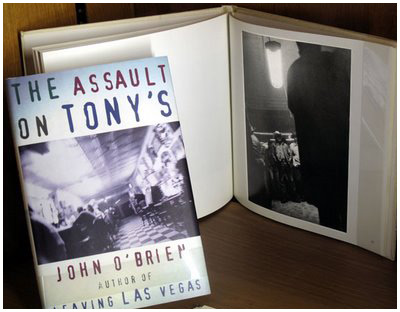
|
| Case 7 / 17 |
  |
Display Case 7 (Frank, Steiner)
Most viewers familiar with the photographer Robert Frank's magnum opus The Americans will know that the images on the two book covers shown here aren't his, but not necessarily without first experiencing a moment of déjà vu.
There are, no doubt, an endless number of photographs that depict roads leading off into nowhere, many taken by important photographers. While Robert Frank is hardly the first to have produced such a picture, the bleak, poetic beauty of U.S. 285, New Mexico has made it one of the more popular and quoted versions of the genre.
Rosanne Wilson's drawing for the cover of Freya Manfred's book of poems, American Roads appears to have been modeled after Frank's image. Although the road lines in Wilson's drawing have been flipped, the oncoming car is closer and telephone poles have been added, the image proportions are virtually identical to those of Frank's photograph.
|

Title: American Roads
Author: Freya Manfred
Publisher: Overlook Press 1979
Designer / Illustrator: Rosanna Wilson.
|

|
The cover photo for The Assault on Tony's (credited not to an individual but 'courtesy of [the photo agency] Photonica') appears generally derivative of Frank’s influential vision, and specifically reminiscent of Bar, Gallup, New Mexico. The setting, the tilt, the way the image is contained by its edges, and the heightening of tension by obscuring detail all find their source in the 26th picture in Franks landmark book.
A final detail worth noting: the publisher of this book is Grove Press; the same house that, 37 years earlier, published The Americans.
Title: The Assault On Tony’s
Author: John O’Brien
Publisher: Grove Press 1996
Designer / Illustrator: John Gall
Photographer: ‘courtesy of Photonica’.
|
American Rural Baroque, made by Ralph Steiner in 1929, is one of his best known photographs, predating Grant Wood's American Gothic by one year. In addition to being a sterling example of Modernist photographic formalism, it serves to portray, and preserve, an archetype of rural Americana. From the warmth of the light to the carefully crafted intricacies of the chair back, one feels a sense of peace, but also of melancholy.
Designer Kathleen Digrado's photo, also of a chair on a front porch, calls Steiner's image to mind. It is used for the cover of Michael Winerip's 9 Highland Road, a book about metal illness and institutionalized living. In Digrado's photo, the empty chair and its shadow serve as a symbol of absence (both literal and emotional) as well as representing the threshold between confinement and freedom. While the shadow of Steiner's chair manifests itself as an engaging optical puzzle, the chair on the cover of Winerip's book casts the ominous shadow of bars on a stone wall.
Was Kathleen Digrado in some way influenced by Ralph Steiner? Was she consciously aware of his work, or did she subconsciously absorb it, conceivably from a slide presentation in a photo history class, or while paging through an anthology? Or, perhaps just as likely, is there no connection whatsoever? To see an object and its shadow as a potential picture does not, after all, require a genius-level aesthetic sensibility; it is a common enough visual motif, even for beginning photography students. What is it, in this case, about the nature of substance and shadow that compels the image-maker to commit it to film?
|

Title: 9 Highland Road
Author: Michael Winerip
Publisher: Vintage Books 1995
Designer / Illustrator: Kathleen DiGrado.
|
|
Write your comments:
|
|
